technical specifications Alfa Romeo 8C 2009 Owner handbook (in English)
[x] Cancel search | Manufacturer: ALFA ROMEO, Model Year: 2009, Model line: 8C, Model: Alfa Romeo 8C 2009Pages: 223, PDF Size: 14.35 MB
Page 11 of 223

1
2
3
4
5
6
7
8
9
VEHICLE IDENTIFICATION DATA
ACTIVE AND PASSIVE SAFETY
INSTRUMENTS AND CONTROLS
BEFORE YOU DRIVE
USING THE VEHICLE
IN AN EMERGENCY
CAPACITIES AND TECHNICAL SPECIFICATIONS
MAINTENANCE
TABLE OF CONTENTS
Page 12 of 223
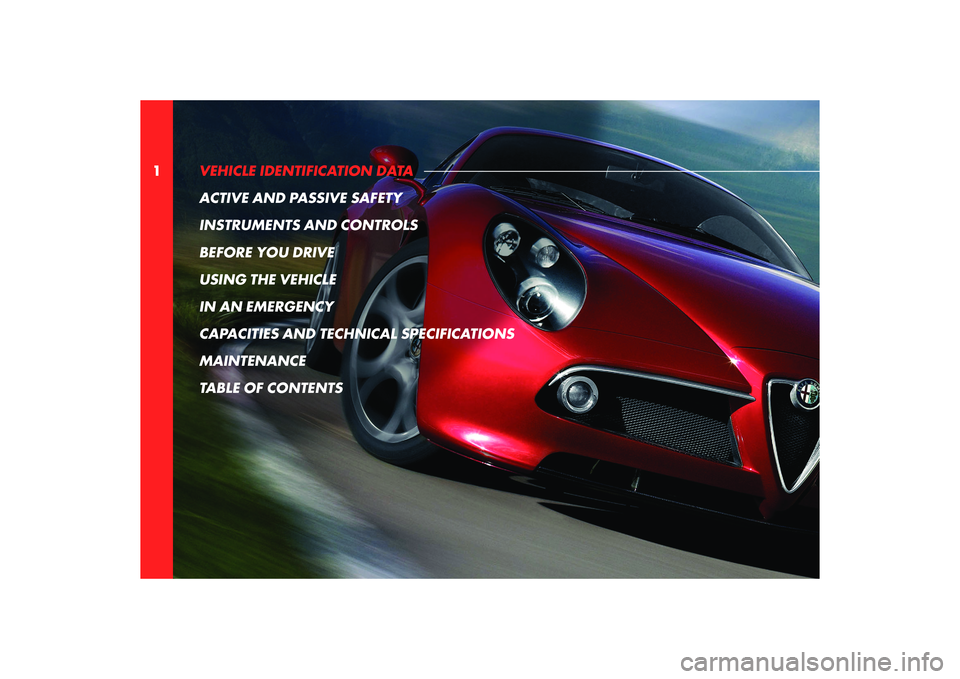
1VEHICLE IDENTIFICATION DATA
ACTIVE AND PASSIVE SAFETY
INSTRUMENTS AND CONTROLS
BEFORE YOU DRIVE
USING THE VEHICLE
IN AN EMERGENCY
CAPACITIES AND TECHNICAL SPECIFICATIONS
MAINTENANCE
TABLE OF CONTENTS
Page 18 of 223
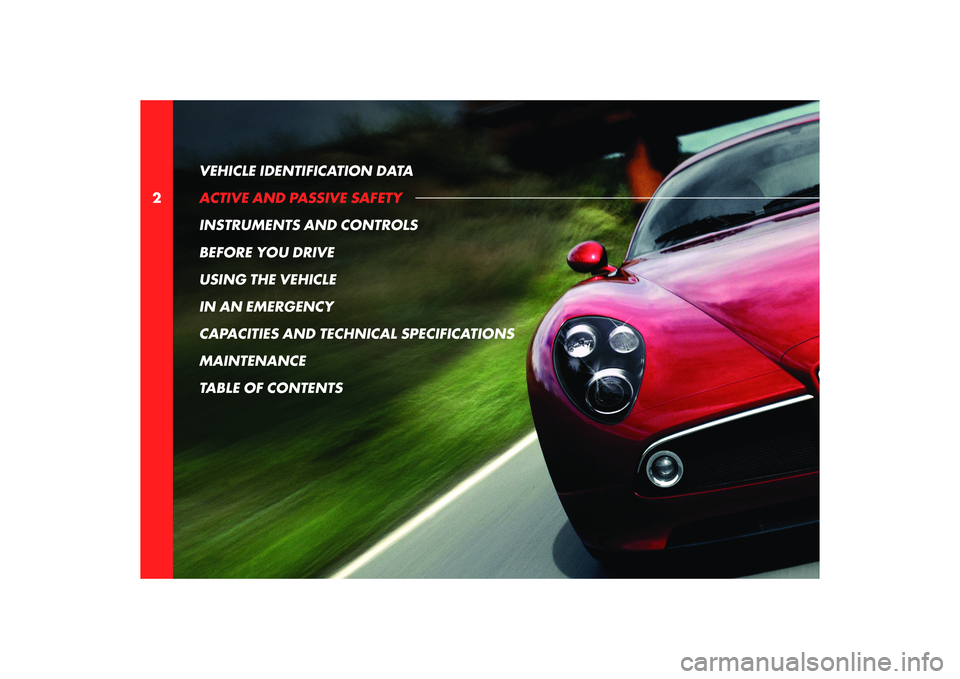
2VEHICLE IDENTIFICATION DATA
ACTIVE AND PASSIVE SAFETY
INSTRUMENTS AND CONTROLS
BEFORE YOU DRIVE
USING THE VEHICLE
IN AN EMERGENCY
CAPACITIES AND TECHNICAL SPECIFICATIONS
MAINTENANCE
TABLE OF CONTENTS
Page 42 of 223
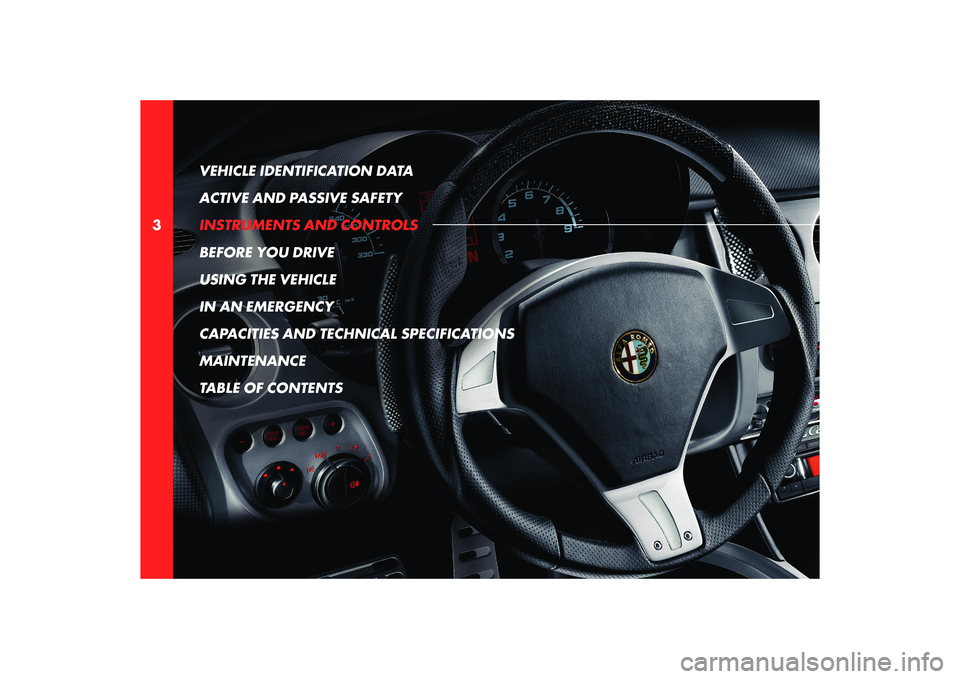
3VEHICLE IDENTIFICATION DATA
ACTIVE AND PASSIVE SAFETY
INSTRUMENTS AND CONTROLS
BEFORE YOU DRIVE
USING THE VEHICLE
IN AN EMERGENCY
CAPACITIES AND TECHNICAL SPECIFICATIONS
MAINTENANCE
TABLE OF CONTENTS
Page 78 of 223
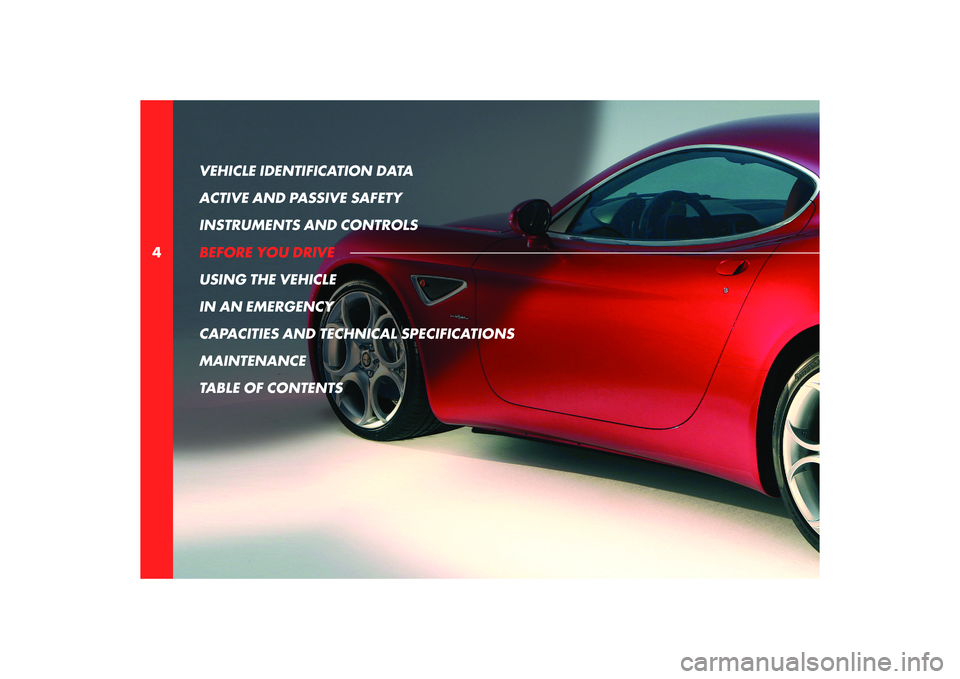
4VEHICLE IDENTIFICATION DATA
ACTIVE AND PASSIVE SAFETY
INSTRUMENTS AND CONTROLS
BEFORE YOU DRIVE
USING THE VEHICLE
IN AN EMERGENCY
CAPACITIES AND TECHNICAL SPECIFICATIONS
MAINTENANCE
TABLE OF CONTENTS
Page 84 of 223
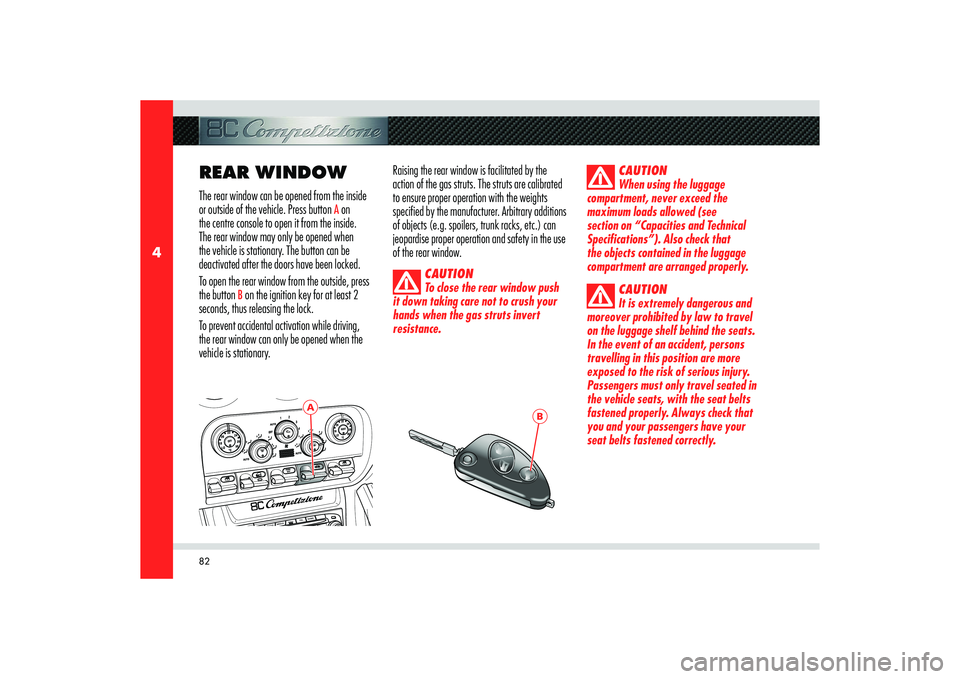
82
4
A
B
REAR WINDOWThe rear window can be opened from the inside
or outside of the vehicle. Press button
A on
the centre console to open it from the inside.
The rear window may only be opened when
the vehicle is stationary. The button can be
deactivated after the doors have been locked.
To open the rear window from the outside, press
the button
B on the ignition key for at least 2
seconds, thus releasing the lock.
To prevent accidental activation while driving,
the rear window can only be opened when the
vehicle is stationary.Raising the rear window is facilitated by the
action of the gas struts. The struts are calibrated
to ensure proper operation with the weights
specified by the manufacturer. Arbitrary additions
of objects (e.g. spoilers, trunk racks, etc.) can
jeopardise proper operation and safety in the use
of the rear window.
CAUTION
To close the rear window push
it down taking care not to crush your
hands when the gas struts invert
resistance.
CAUTION
When using the luggage
compartment, never exceed the
maximum loads allowed (see
section on “Capacities and Technical
Specifications”). Also check that
the objects contained in the luggage
compartment are arranged properly.
CAUTION
It is extremely dangerous and
moreover prohibited by law to travel
on the luggage shelf behind the seats.
In the event of an accident, persons
travelling in this position are more
exposed to the risk of serious injury.
Passengers must only travel seated in
the vehicle seats, with the seat belts
fastened properly. Always check that
you and your passengers have your
seat belts fastened correctly.
Page 114 of 223

5VEHICLE IDENTIFICATION DATA
ACTIVE AND PASSIVE SAFETY
INSTRUMENTS AND CONTROLS
BEFORE YOU DRIVE
USING THE VEHICLE
IN AN EMERGENCY
CAPACITIES AND TECHNICAL SPECIFICATIONS
MAINTENANCE
TABLE OF CONTENTS
Page 133 of 223
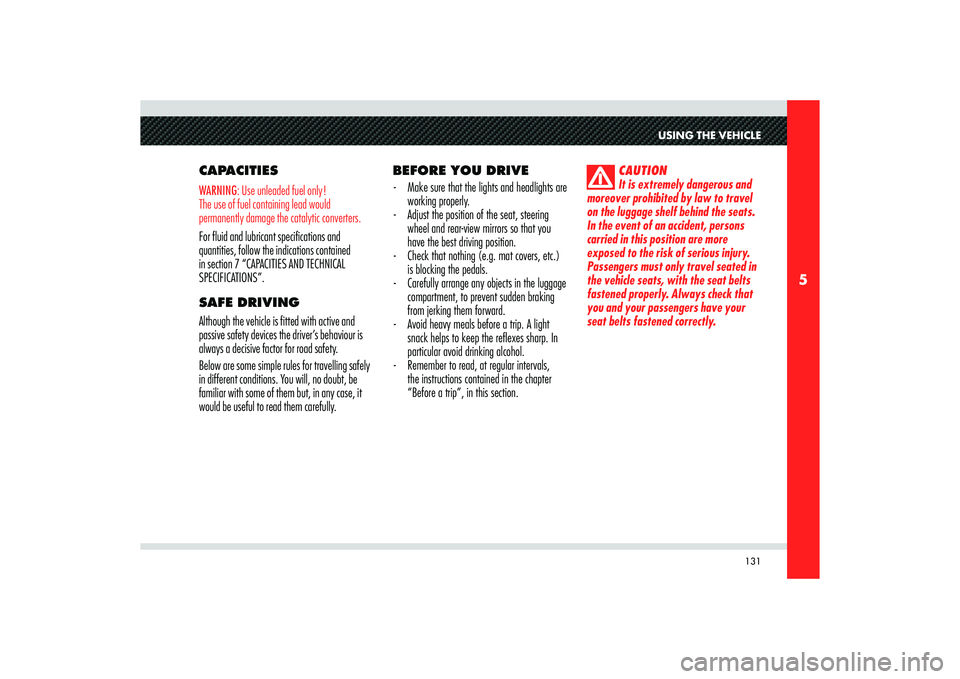
131
5
USING THE VEHICLE
CAPACITIESWARNING: Use unleaded fuel only!
The use of fuel containing lead would
permanently damage the catalytic converters.For fluid and lubricant specifications and
quantities, follow the indications contained
in section 7 “CAPACITIES AND TECHNICAL
SPECIFICATIONS”.
SAFE DRIVING
Although the vehicle is fitted with active and
passive safety devices the driver’s behaviour is
always a decisive factor for road safety.
Below are some simple rules for travelling safely
in different conditions. You will, no doubt, be
familiar with some of them but, in any case, it
would be useful to read them carefully.BEFORE YOU DRIVE
- Make sure that the lights and headlights are
working properly.
- Adjust the position of the seat, steering
wheel and rear-view mirrors so that you
have the best driving position.
- Check that nothing (e.g. mat covers, etc.)
is blocking the pedals.
- Carefully arrange any objects in the luggage
compartment, to prevent sudden braking
from jerking them forward.
- Avoid heavy meals before a trip. A light
snack helps to keep the refl exes sharp. In
particular avoid drinking alcohol.
- Remember to read, at regular intervals,
the instructions contained in the chapter
“Before a trip”, in this section.
CAUTION
It is extremely dangerous and
moreover prohibited by law to travel
on the luggage shelf behind the seats.
In the event of an accident, persons
carried in this position are more
exposed to the risk of serious injury.
Passengers must only travel seated in
the vehicle seats, with the seat belts
fastened properly. Always check that
you and your passengers have your
seat belts fastened correctly.
Page 143 of 223

141
5
USING THE VEHICLE
TYRESTYRE INFLATION
PRESSURE WHEN COLD
The tyre inflating ratings shown in this manual
must be read as values applicable with cold
tyres.
CAUTION
When winter tyres are fitted,
it is advisable not to exceed a speed
of 220 km/h. Always observe the
regulations in force in the country
where you are driving and follow
the instructions provided by the tyre
manufacturer.
CAUTION
When using the spare wheel
(emergency wheel) do not exceed 80
km/h. Avoid driving at full throttle,
braking sharply and cornering at high
speeds.
WINTER TYRES
These tyres are specially designed for driving on
snow and ice and are fitted to replace the ones
supplied with the vehicle.
CAUTION
Only use winter tyres having
the same dimensions as those provided
with the vehicle or as indicated on
page 186.
The Authorised Service Centres of the
Manufacturer’s Network are available to
provide suggestions as to the types of tyres most
suited to the use foreseen by the Customer.
For the type of tyres to use, inflation pressures
and relative specifications for winter tyres,
carefully follow the indications found in the
section “Capacities and technical specifications”.
The features of these tyres are markedly reduced
in winter when tread depth is less than 4 mm. In
this case, they should be replaced.The specific features of the winter tyres lead to
lower performance under normal environmental
conditions or on long highway trips, compared to
the standard tyres.
Therefore, they should only be fitted for
their intended use, for which they have been
approved.
CAUTION
Fit identical (manufacturer and
tread) tyres on all four wheels, in
order to ensure safe driving, braking
and good manoeuvrability.
CAUTION
Remember that the direction of
tyre rotation should not be reversed.
Page 146 of 223

6VEHICLE IDENTIFICATION DATA
ACTIVE AND PASSIVE SAFETY
INSTRUMENTS AND CONTROLS
BEFORE YOU DRIVE
USING THE VEHICLE
IN AN EMERGENCY
CAPACITIES AND TECHNICAL SPECIFICATIONS
MAINTENANCE
TABLE OF CONTENTS